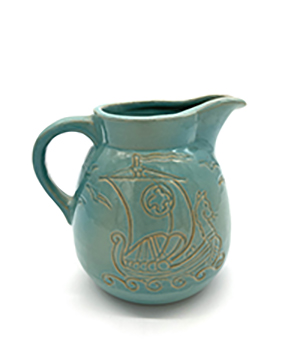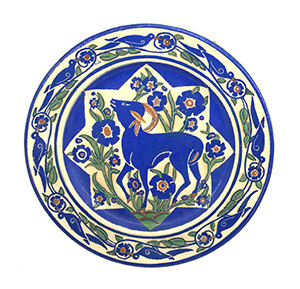Pottery of the prairie
During Women’s History Month, we remember Margaret Cable and her lasting legacy of UND Pottery

Women weren’t allowed to vote – nor did they run departments – when Margaret Kelly Cable established a ceramics program at UND.
And despite all odds, Cable built a ceramics program and left a legacy of beauty that remains today.
“Margaret Cable’s is the story I love to tell the most,” said Sarah Heitkamp, UND Art Collections manager and curator. “Her accomplishments here at UND and beyond are so remarkable and inspiring. She and the women she hired to work with her were more than artists. They were scientists and entrepreneurs.”
Head of the UND ceramics department from 1910 to 1949, Cable designed and made beautiful vases, pots and other ceramics. She taught thousands of students and gave lectures and demonstrations across the nation. Her works, all marked with the distinctive cobalt blue School of Mines logo, are treasured – and valuable – masterpieces.
“The pieces created during the Cable era have become very collectible,” Heitkamp said. “They’ve been featured on Antiques Roadshow numerous times, and there are entire clubs devoted to North Dakota pottery and its history, with UND Pottery from the Cable era being the most coveted.” A slideshow of UND Pottery is available on UND’s Scholarly Commons.
An artistic explosion
Cable was recruited by Earle Babcock, a UND chemistry instructor and state geologist who would later become dean of engineering & mines and acting president of UND.

His goal was to use state resources for economic development. Babcock envisioned making sewer pipe, paving brick, roofing tile, and ornamental brickwork from North Dakota clay, which is of an especially high grade.
Born in Crookston, Minn., Cable trained at the Handicraft Guild in Minneapolis, which was founded by women and at the time was a national center for the Arts & Crafts Movement.
And though she began making “useful” items from clay, she soon designed and crafted decorative pieces that incorporated North Dakota’s prairie and agricultural roots – the prairie rose, coneflowers, wheat, birds and flickertails, American Indian and western motifs – all in the Arts & Crafts and Art Noveau movements.
Within just a few years, UND pottery was shown across the country. She exhibited at the Panama-Pacific Exposition in 1915, and her work was shown at the Art Institute of Chicago and the Century of Progress Exposition in Chicago in 1933, gaining national attention.
“Margaret Cable is so interesting because she was appointed to her position without a college degree,” Heitkamp said. “She was so dedicated to her craft, and a natural leader who was able to quickly and successfully create and maintain a ceramics program for UND, even through the Great Depression.”
A gifted teacher
In addition to crafting pottery, Cable was an excellent teacher who drew students. By 1921 she was teaching 60 students and had a waiting list. In 1925, the list had grown to 70, even with three assistant teachers.

“I’ve read through one of her teaching binders, and it’s obvious how much care and detail was put into every single thing she did,” Heitkamp said. “She kept clippings from papers, student research, her own research, class notes, drawings, and even pressed leaves for inspiration. She didn’t have textbooks, so she wrote her own tutorials and shared them as far and wide as she could. She was also an incredible mentor who hired smart, hard-working women to help teach and run the program.”
“The Lady of the Wheel,” as she became known for her demonstrations at the potter’s wheel, spoke at women’s groups and clubs across the state and nation, and was asked to make presentation bowls and pieces for dignitaries, including President John F. Kennedy, Crown Princess Martha of Norway and Queen Marie of Romania. Governor A.G. Sorlie commissioned her to design and make what became the North Dakota Products Vase, which remains one of her greatest achievements.
Cable was remarkably adept at politics in a man’s world, and often gave gifts of pottery to the wives of public officials who could aid the UND ceramics program.
She was one of very few women at the time to be accepted into the American Ceramics Society, and she presented a paper at their annual meeting in 1922, which was later published in their Journal, highly unusual for a woman at that time.
She was named North Dakota Outstanding Woman of the Year in 1927, and was invited to the Women’s World Fair in Chicago, where for 10 days she threw pottery, exhibited, gave lectures, and was featured in multiple publications.
Innovator and entrepreneur
Throughout her 39 years at UND, Cable worked tirelessly, often under very difficult conditions. Despite budget issues, prevailing attitudes about women, and poor facilities, Cable drew students and accolades.

During the Great Depression, when salaries were cut and funding for the Ceramics Department was withdrawn, Cable sold her home and moved to a small apartment in order to keep the ceramics department going.
“During the harder times she really shined as an innovator and an entrepreneur,” Heitkamp said. “She sold pottery to retail stores, taking special commissions, and at one point her department was completely self-funded. Her production levels were prolific. With the help of students and her staff, she was able to put thousands of pieces of pottery into the hands of the public.”
Today, UND is home to approximately 2,000 Cable era works, with public displays in the Gorecki Alumni Center and Hughes Fine Arts Center.
“Margaret Cable was truly the best of UND,” Heitkamp said. “Anyone who owns a piece of her pottery is holding a piece of UND and a piece of women’s history. It’s a piece of her legacy.”


